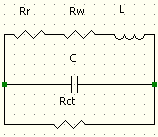 Home
Home Up
Up Search
Search Mail
Mail
NEW
Lumped parameters (acoustic -> electrical)
JavaScript calculations can be done below.
The acoustical parameters of the elements can be translated to
electrical parameters. I am using information from Calvert
[2003],
Kinsler ([2000], chapter
8.9 and 10.8) and Colman (pers. comm. [2006]). In the below it is
assumed that
the acoustic circuit is in size
much smaller compared to the
acoustical wavelength and that it is the air.
I am wondering how well the below theoretical model works for
attenuation/resistance, reading
this:
The
attenuation of sound in air due to viscous, thermal and rotational loss
mechanisms is simply proportional to f 2. However, losses due to vibrational
relaxation of oxygen molecules are generally much greater than those
due to the classical processes, and the attenuation of sound varies
significantly with temperature, water-vapour content and frequency.
More study is needed to include at least molecules level attenuation
and influence of humidity. I hope that within the environment of
neolithic buildings these influence are not large (except the humidity
perhaps). Help is needed!
Acoustical inductance of a pipe
| L' = ρL/(πa2) [H'] |
Kinsler [2000], formula (10.8.1) and (10.9.5)
|
with:
ρ = air density:
1.293 [kg/m3] (0°C, 1 atm)
L = effective length of pipe [m]
a = radius of pipe [m2]

Acoustical resistance of a pipe
Thermal and viscous resistance due wall
losses in pipe
Non capillary pipe
| Rw' = (1.46*L/(πa3))√(4πρηf)
[Ohm'] |
Kinsler [2000], formula (10.8.10) and (10.9.5) |
with:
η = dynamic
viscosity of air, 1.71 x 10-5 [kg/m-sec] (0°C, 1 atm)
f = frequency [Hz]
Capillary pipe (Reynolds number is less
than 2000)
| Rwc'
= 1.46*8ηL/(πa4) [Ohm'] |
Oban [2003],
factor 1.46: Kinsler [2000], formula
(8.9.19) |
Radiation resistance (open segment)
| Rr' = 2πρf2/c
(flanged) [Ohm'] |
Kinsler [2000], formula (10.8.9) and (10.9.5) |
| Rr' = πρf2/c
(unflanged) [Ohm'] |
Kinsler [2000], formula (10.8.9) and (10.9.5) |
Acoustical capacitance of rigid
container/cavity
| C' = V/(ρc2) [F'] |
Kinsler [2000], formula (10.8.4) and (10.9.5) |
with:
c = sound speed in air:
331.5 [m/sec] (0°C, 1 atm)
V = volume of container [m3]

Thermal resistance in container
| Rct' = ρc2/(0.46*√(πηf/ρ)*A)
[Ohm'] |
Coltman,
pers. comm [2006]
|
with:
A = area of cylinder with radius a and length 2*a, where a is such that
the cylinder has volume V
Helmholtz resonator

Frequency
| fhelm = 1/(2π√(L'C'))
[Hz] |
Calvert [2003] |
Quality factor
| Qhelm = 2πfhelmL'*(
1/(Rw'(fhelm)+
Rr'(fhelm))+1/Rct')
[-] |
|
Calculations
Browser must have JavaScript enabled
As example a
Florence flask is used.
Disclaimer and Copyright
 Home
Home Up
Up Search
Search Mail
Mail
Major content related changes: Jan. 20, 2006


